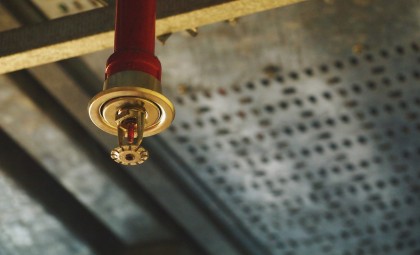Winter Risks: After Hours Sprinkler Leakage

Please Note: This article was originally published in February, 2023. All resources and practical advice showcased below have been updated as of December, 2025.
At HIROC, our partners play an integral role in sharing learnings from prior losses and best practices. This loss example from our property insurance partner FM highlights the risk of sprinkler damage during cold seasons.
HIROC and our partners are here for you. Subscribers with questions around coverage or mitigation of risks can reach out to Jean Asuncion, Senior Account Executive, at [email protected], or email [email protected].
A hospital facility in the U.S. was exposed to extremely cold weather. The dampers in the generator room had been opened accidentally, allowing cold air to enter and freeze the sprinkler piping. The frozen sprinkler pipe subsequently ruptured, dumping sprinkler water all over the floor of the generator room, adjacent areas, and two levels below.
The pipe ruptured in an area which was not occupied during nighttime hours and security cameras captured footage of water present on the floor. More than an hour had passed before building maintenance responded and the fire department was contacted. The fire department personnel immediately determined the location of the water leak and shut off the sprinkler control valve within the generator room.
After the source of the water leak was isolated, cleanup operations began immediately. Damage had extended to the elevators, drywall, insulation, flooring, ceiling tiles, IT and generator switch gears and UPS equipment. Although a detailed water leakage emergency response plan was in place, it was delayed in being activated, allowing the water to flow for an extended period. The emergency response team also ignored the fire pump running alarm and the water flow alarm for one hour, delaying notification to the maintenance team and fire department. If the alarms had been heeded, the amount of damage may have been limited to a significantly smaller area. The total amount of this claim was $1.5 million USD.
So Now What?
The events described above are just one example of what can go wrong when freezing temperatures occur. In Canada our healthcare organizations are no strangers to the sting of cold weather. But with proper planning, we can work to mitigate some weather-related risks.
Here are a few practical steps you can take right now:
- Appoint a "weather watcher" to monitor weather conditions—24 hours' notice can make a big difference.
- Maintain temperatures in key areas above 4⁰C.
- Develop an emergency plan that considers actions to take if your heating system fails for an extended period.
- Check both wet and dry-pipe sprinkler systems regularly to make sure they are ice-free and remain in service to protect your organization from a fire.
- For wet-pipe sprinkler systems, ensure that the protected area, and any area the sprinkler pipework runs through, is maintained above 4⁰C.
- For dry-pipe sprinkler systems, drain low points on the system before the winter period to ensure no water is trapped.
- Monitor the amount of snow on the roof and have a plan to clear it before accumulations reach unsafe levels.
- Ensure employees are trained to mitigate winter-related risks.
- Leak detection systems could help notify personnel of potential failures sooner. Although, sprinkler system waterflow alarms should detect a release of sprinkler water.
- Modern building automation systems may be configurable to remotely notify building management of temperature setpoint deviations in the building (such as freezing in a stairwell or other area that would normally be heated).
By: Christopher Brandonisio, Account Consultant at FM
HIROC and our partners are here for you. Subscribers with questions around coverage or mitigation of risks can reach out to Jean Asuncion, Senior Account Executive, at [email protected], or email [email protected].